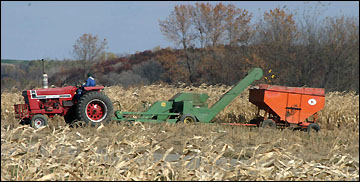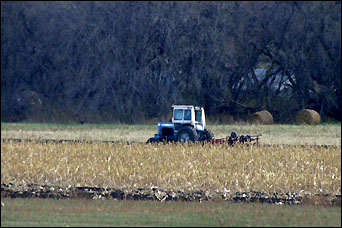Corn harvest appears better than expected
Soybean yields, however, proved disappointing.
Because of ideal weather conditions, the area corn harvest is about three weeks ahead of schedule, said Meeker County Extension Educator Dave Schwartz. This is good news for farmers who struggled to harvest crops in 2002 when wet weather kept them out of fields.
 Farmers combining corn in the last few weeks have been pleased with the results, said Schwartz, with yields higher than they expected.
Farmers combining corn in the last few weeks have been pleased with the results, said Schwartz, with yields higher than they expected.
A farmer near Rice Lake harvests his corn crop last week.
Yields at Ray Nietfeld's farm near Lake Henry have been 170 to 180 bushels per acre, very good considering there was no rain from early July through August, he said. Last year his corn yield averaged 195 bushels.
Hawick farmer Ronald Thorson was also pleased with his corn crop. Yields in fields with light soils weren't great, he said, but areas with heavier soils - as well as areas that he irrigated - were much better than he expcected.
Many area farmers, though, chopped corn for silage in the late summer when drought conditions started affecting the crop. Chopping was a way to salvage corn that may have become too dry to use as forage.
Most area farmers finished harvesting soybeans weeks ago. According to John VanderBeek of the Paynesville Farmers Union, the drought hit soybeans hard because it occurred during a time when beans were developing.
Soybean aphids also hurt yields more than anyone realized, said VanderBeek, with infested fields yeilding as much as 15 bushels per acre less than similar fields without aphids.
Soybean yields in Stearns County were as low as five bushels per acre in high sandy areas, and as high as 50 bushels in low areas under irrigation, said Dan Martens, Benton County Extension Educator. Most farmers would consider 50 bushels an excellent yield, he added.
Gene Passmore, who farms southwest of Paynesville, sprayed some of his soybean fields but still had a disappointing harvest. His fields yielded 16 to 25 bushels of beans. He blames weather that was too wet in the spring for early planting and too dry in the summer.
The dry growing conditions this year had a few positive effects on crops. Because of the weather, farmers were able to complete their harvest early, and because of dry conditions, crop moisture levels are low.
Dry weather helped speed up the harvest throughout Minnesota. Statewide, the corn harvest was 70 percent done as of Monday, Oct. 20, compared to just 16 percent last year when wet conditions hindered harvest. The five-year average for corn harvested by this date is 51 percent. This number includes corn that was chopped for silage late last summer.
Because harvest conditions have been so favorable, many farmers have been able to plow fields and prepare them for spring. Fall tillage is good because it allows fields to warm sooner in the spring, said Schwartz, giving farmers a jump on planting.
Nietfeld finished harvesting corn last week and had time to prepare his fields for next year. At this time last year, he still was trying to harvest in mud.
 Also because of the dry weather, moisture levels in many corn and soybean crops are so low that farmers find they are spending less money on crop drying than last year when the near record harvest came out of the fields very high in moisture.
Also because of the dry weather, moisture levels in many corn and soybean crops are so low that farmers find they are spending less money on crop drying than last year when the near record harvest came out of the fields very high in moisture.
In fact, because moisture levels are so good, the sale of liquid propane at Paynesville Farmers Union, the fuel used in grain drying bins, is down by more than half from this time last year, said employee Dave Spanier.
Because of weather conditions, the area's corn harvest is almost done and many area farmers, including the one pictured here, began plowing their fields to get a jump on spring planting.
Last year, Nietfeld had an exceptional harvest but the moisture level was much higher. This year he won't need to dry corn, which could save him enough money on fuel to nearly make up for the yield loss.
When Thorson began harvesting corn several weeks ago, the moisture level was about 21 percent and required drying, but corn harvested last week required little or no drying.
The statewide average moisture level for corn harvested last week was 17 percent compared to 22 percent last year.
Soybeans also needed little or no drying. The average moisture level of beans harvested last week was 11 percent compared to 14 percent last year.
While farmers prepare for the next growing season, researchers at the University of Minnesota will do more research on the soybean aphid that caused so much damage to crops throughout the midwest, said VanderBeek. Their results probably won't be available until early 2004, but Vanderbeek believes that farmers should be prepared for the insects next year.
Contact the author at editor@paynesvillepress.com • Return to News Menu
Home | Marketplace | Community